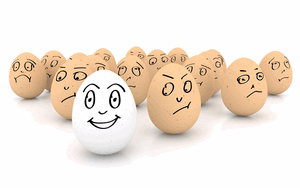 If you are going to have a bet on a regular basis then it is vitally important that you fully understand betting odds and how they work. Odds prices are simply a number that indicates to the bettor the financial return that is available if that selection wins.
If you are going to have a bet on a regular basis then it is vitally important that you fully understand betting odds and how they work. Odds prices are simply a number that indicates to the bettor the financial return that is available if that selection wins.
For each event a book is created that gives the betting odds for each competitor/team taking part. These odds roughly reflect the real probability of that competitor winning but will give an indication of the chances.
The odds of Manchester City winning the Premier League will be much shorter than for Everton winning it, this is because the bookmaker believes – based on their research and evidence – that City have a better chance of winning the title than the Merseyside team.
The lower the odds a bookmaker offers, the more they believe that scenario will occur. Odds, however, are impacted by lots of things, such as popularity – the more people bet on something the lower the price goes; and opinion – the more positive noises there are the lower the prices go. This is why it can be possible, on rare occasions, to find odds that are actually better than probability dictates.
Remember though, prices also have a profit margin for the bookie built in, so on balance, odds are always lower than real probabilities dictate. This is why they say “the bookmaker always wins”.
Different Odds Formats Explained
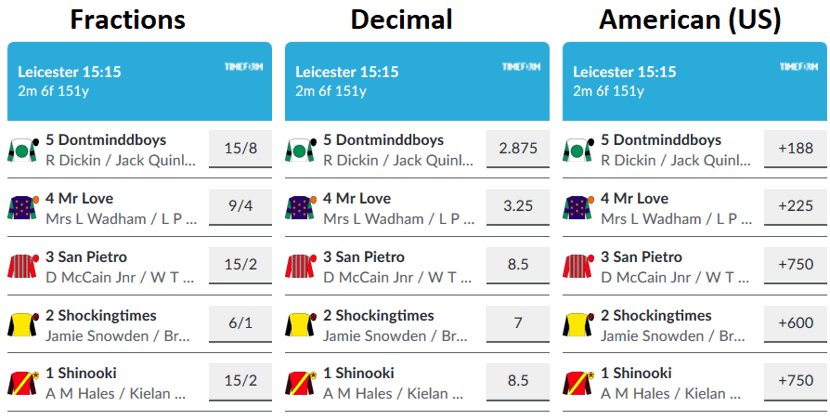
There are three main ways of expressing odds, namely decimal odds, fractional odds, and American odds, with other Asian variations such as Malaysian, Chinese, and Indonesian.
Fractional Odds
 These are the odds that most of us in the UK grew up with. Go into any bookmakers shop and the odds will be in fractional form. In Britain, you will find everyone seems to talk about their selection being 2/1 rather than ‘oh it’s 3.0.’
These are the odds that most of us in the UK grew up with. Go into any bookmakers shop and the odds will be in fractional form. In Britain, you will find everyone seems to talk about their selection being 2/1 rather than ‘oh it’s 3.0.’
How do you go about understanding fractional odds? Well, if a selection is priced up at say 5/2, then for every ‘2’ you bet, you will get ‘5’ back; the figure on the left indicates how much you’ll win and the one on the right refers to the stake needed to win that amount. Therefore, if you place £2 you will win £5 plus your stake back (£7 total). This is described as being odds against, or positive odds.
Many bets, as is the case with a lot of favourites, will be odds-on or negative. That means the figure on the left will be smaller than the one on the right. If it’s 10/11 you have to bet £11 to win £10, plus your stake back.
There’s a whole range of fractional prices available, for example, 2/1, 9/4, 5/2, 11/4. In that example, each of the odds is slightly higher than the previous one. Recent years have seen more fractional odds appearing, such as 11/5 and 85/40, to allow for minor changes and cover a wider range of prices.
Learning the fractional odds is really important if you want to be able to successfully gauge how the market is moving. For example, which of these odds is the shortest: 7/5 or 11/8? It’s simply a case of dividing the figure on the left by the one on the right. 7 divided by 5 = 1.4 and 11 divided by 8 = 1.375, therefore 7/5 is slightly higher than 11/8.
Decimal Odds
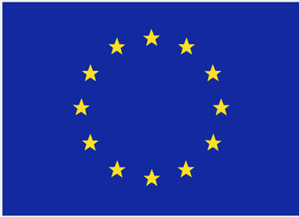 If you grew up in Europe you may be more familiar with decimal odds. It makes sense given that Europe has embraced the metric system whereas in the UK we are still semi-Imperial, hence the fractions for odds.
If you grew up in Europe you may be more familiar with decimal odds. It makes sense given that Europe has embraced the metric system whereas in the UK we are still semi-Imperial, hence the fractions for odds.
The rising popularity of online betting however means that even if you are British you will have encountered this format more and more. Especially if you’ve tried betting with more continental bookie’s sites where the default odds can often be decimal, or if you’ve tried more exotic bets such as Asian Handicaps, where odds are generally shown in decimal.
With decimal odds the big difference is that the odds shown include your stake money that will be returned if you win. For example, 2/1 in fractional odds simply explains that if you stake £1 then you’ll win £2, plus your £1 stake back. Now, in decimal terms, this is represented as 3.0. This means for a £1 stake you will receive £3.00 back if your bet is a winner, however, there is no need to add your stake back on as it is included already.
The key figure in decimal odds is 2.0, the equivalent of evens in fractional betting. If the decimal odds are less than 2.0 then this is the equivalent of an odds-on shot in fractional odds. For example, 1/2 in fractional odds is 1.5 in decimal, as £1 wins you 50p so your return is £1.50.
American Odds
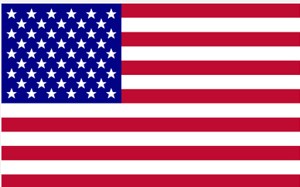 American odds are also sometimes called lines or money line odds. These do take a bit of getting used to from my experience.
American odds are also sometimes called lines or money line odds. These do take a bit of getting used to from my experience.
For positive odds, you’ll see a “+” sign, and this tells you how much you’d win with a stake of 100 units. For negative odds you will see a “–” sign, and this shows how much you will need to stake to win £100.
For example, if the fractional odds are 4/1, the decimal odds would be 5.0 (as it includes the return of the stake) and in US odds it would be given as +400. Here a stake of 100 will generate a profit of +400 if the bet wins.
For negative odds of say 1/4 (1.25 decimal) American odds would be -400, showing you how much you will need to stake (400) in order to win 100.
Other Odds Formats
 Other odds formats exist such as Hong Kong, Indonesian, Chinese Malaysian and others, although these are rarely found as standard at any sites a UK punter would use.
Other odds formats exist such as Hong Kong, Indonesian, Chinese Malaysian and others, although these are rarely found as standard at any sites a UK punter would use.
If you want to bet with these odds formats you may need to shop around a little. BetVictor, for example, are good for offering 5 or 6 variations.
In summary, other odds formats work as follows:
Hong Kong / Chinese Odds
This is basically the same as decimal however it doesn’t include the stake. So whereas evens in decimal format is 2.0, in Chinese it would be 1.0. 7/1 in decimal would be 8.0, in Hong Kong it would be 7.0, etc.
Indonesian Odds
Very similar to American odds except measured in units of 1 rather than 100. When positive, the number reflects the size of the bet needed to make a profit of 1. When negative, they show the profit you can make from a wager of 1.
Malaysian Odds
Similar to Indonesian odds, Malaysian odds are also based on units of 1, however, the system is inverted. When odds are positive, say 2/1, in Malaysian this is represented as -0.5, you multiply the stake by odds to give profit; for every one unit profit you need 0.50 stake. For negative odds, you divide the stake by the odds, e.g. 1/2 is now 0.5; you make a profit of 0.50 for every 1 unit staked.
Odds Conversions
| Fractions | Decimal | American (US) | Chinese | Indonesian | Malaysian |
|---|---|---|---|---|---|
| 1/10 | 1.10 | -1000 | 0.10 | -10.0 | +0.1 |
| 1/4 | 1.25 | -400 | 0.25 | -4.0 | +0.25 |
| 1/2 | 1.50 | -200 | 0.50 | -2.0 | +0.5 |
| 4/6 | 1.66 | -150 | 0.66 | -1.50 | 0.66 |
| Evens | 2.0 | -100 | 1.0 | -1.0 | 1.0 |
| 6/4 | 2.50 | +150 | 1.50 | +1.50 | -0.66 |
| 2/1 | 3.0 | +200 | 2.0 | +2.0 | -0.5 |
| 4/1 | 5.0 | +400 | 4.0 | +4.0 | -0.25 |
| 10/1 | 11.0 | +1000 | 10.0 | +10.0 | -0.1 |
Once you get used to it, conversions between these different form of odds is fairly straightforward. 4.0 in decimal means £1 will see a return of £4, a profit of £3, so it’s 3/1 in fractional. For the US odds £100 would win £300 so it’s +300.
When you bet online you are given the choice of how you want the odds to be represented. Just click on the one you feel most comfortable with. You can usually toggle between odds at any time with a decent betting site and it is almost instant, so you can switch between them if you want to start getting used ot another format.
Setting Odds and Bookmaker Margins Explained

A bookmaker will offer their customers odds for each event they cover. However, this is a business after all, so they will ensure that the odds that are produced will contain a bit of profit for themselves.
This isn’t necessarily a fixed commission on each bet but rather it is calculated as an overall margin taking into account all the possible bets for a given event, known as a book. If a bookmaker balances a book and takes equal proportions of bets on all outcomes, then whatever the result there will be a profit made by the bookmaker.
How is this achieved? Well, the odds that they offer overall will be slightly less than the true odds overall. The difference between these numbers is the profit margin.
Calculation of odds is defined by many parameters and with real world events like sports it is only a best guess made by a bookmaker. The trick for them is to make all of their guesses slightly conservative, so that on balance they will always win. The bookmaker can get it wrong, though.
Odds are set by both software and odds traders that take into account as much information as possible before setting a price that balances their risk vs attracting people to bet on the market. Remember, bookies need to be competitive at the same time as making money otherwise no one would bet with them. Here are some factors that go into how odds are set:
- Previous form and history of results.
- Popularity of the market, how many people are backing it, and how much are they staking.
- Opinion; what are the experts, pundits, managers, players, etc., saying.
- Other bookies; if all the betting companies start shortening odds then the rest will generally follow.
- Bookies will often inflate or reduce odds to attract or prevent bets on one side of a market to balance a book.
- Risk; the higher risk an outcome is judged to be the more conservative the odds, this happens a lot in one-off or rare events where information is scarce.
Making a Profit
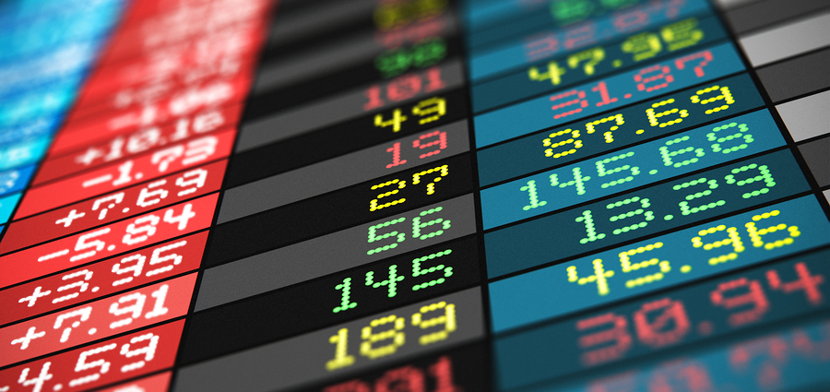
Let’s take a simple example of a match result for a tennis game to limit the number of outcomes to two; win for Player A or win for Player B.
Now, the bookie wants to price the markets to attract people to bet on the outcomes but without leaving them overexposed either way.
The match has one favourite and one underdog, the favourite is priced at 2/1 (3.0) and the underdog priced at 2/5 (1.40).
To work out the margin, divide 1 by the odds in decimal and multiply by 100. Do this for all selections (in this case two) and add them together:
((1/3.0) x 100) + ((1/1.40) x 100) = 33.333 + 71.429 = 104.76
Now subtract 100 from that number (104.76 – 100) and this gives you the margin the bookmaker is taking on that market, 4.76%.
If the bookie can take an equal proportion of bets on both sides then they ensure they always win. If they end up with an unbalanced book they will often increase odds on one side and decrease bets on another to try to balance it up. This is an opportunity where some punters can take advantage of odds that can sometimes be better than probability would dictate. Bookmakers call these weak lines.
Guide to Beating the Odds
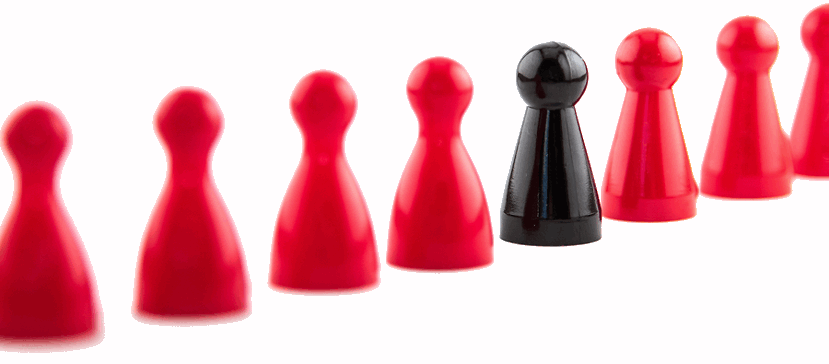
It’s not easy of course to get one up on the bookmakers, they have many more resources to throw at getting their odds right, but they also have thousands of markets to cover, so there will be some times when in setting their odds they haven’t quite taken everything into account.
It won’t happen often as bookmakers employ experts to set their odds and not much gets past them, especially with the main sporting events where lots of information is available and markets are widely bet on.
The best way to beat the odds is to bet on things that are either very skewed one way (encouraging weak lines) or bet on events where there is less information available and therefore more opportunity to find an advantage.
Obscure Markets & Novelty Events
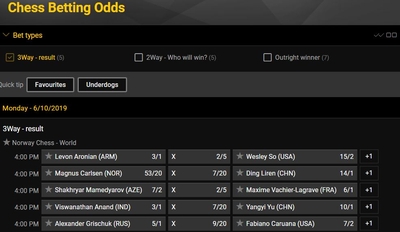 This is a double-edged sword. With many lesser known sports events or novelty bets the odds traders have a difficult job pricing an event. Most bookies wait for one operator to set odds first and then the rest follow. But what if those first predictions are not very accurate?
This is a double-edged sword. With many lesser known sports events or novelty bets the odds traders have a difficult job pricing an event. Most bookies wait for one operator to set odds first and then the rest follow. But what if those first predictions are not very accurate?
This is an opportunity for punters. Let’s say you think you’ve spotted the next Chess Champion but the bookies are still pricing them highly, this is a chance to exploit your knowledge at the companies expense.
A word of caution, however; the less that is known about a market the riskier it is, and the riskier it is the higher the bookies’ margin will be. You will therefore need to be fairly good at spotting these advantage to win this way over a period of time.
Do Research Yourself
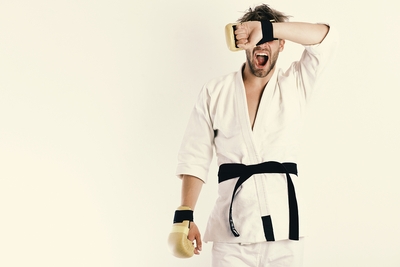 A bit of research is really useful here and there’s plenty available online, but rather than looking at the stats, look at news stories. For example, a player whose partner has just given birth might not be getting all the sleep they should – Andy Murray’s form dipped a bit after he became a father.
A bit of research is really useful here and there’s plenty available online, but rather than looking at the stats, look at news stories. For example, a player whose partner has just given birth might not be getting all the sleep they should – Andy Murray’s form dipped a bit after he became a father.
Does the bookie know that the obscure player on the Challenger circuit just became a father? Might a player have a bad record in some tournaments and so have a mental barrier to overcome? All that research might just get you a winner at a better price.
Look at the odds the bookmaker has set and consider what odds you’d have set yourself. If a player is 2/1 and you think he should be 6/4, then pounce on the 2/1 that is being offered. It’s your prediction against theirs after all, and you might just be right.
Human Error
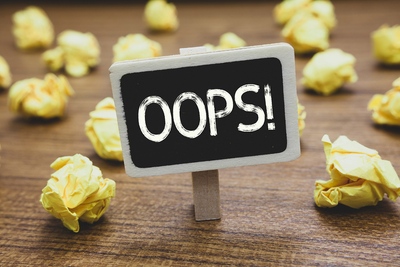 Human errors can occur and there will be some odds that in hindsight look too good to be true. Betting on elections can be profitable as the opinion polls aren’t always to be trusted, take the 2015 UK General Election, for example, or the EU referendum, or the US Donald Trump Election – need I go on?
Human errors can occur and there will be some odds that in hindsight look too good to be true. Betting on elections can be profitable as the opinion polls aren’t always to be trusted, take the 2015 UK General Election, for example, or the EU referendum, or the US Donald Trump Election – need I go on?
The close vote predicted wasn’t what eventually happened and the bookmakers are over-reliant on statistical markers such as polls.
Ocassionally you will find a genuinely mispriced market where the odds have been output incorrectly. By all means, bet on it, but in all likelihood the bookie they will void the bet once they spot it; bookmakers have terms that cover them for ‘palpable errors’ where they can claim an obvious mistake.
The Hunch
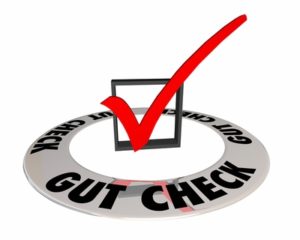 If you believe a horse that is about to make its racecourse debut may be a future superstar, then some good odds, particularly in ante-post betting markets, may be available.
If you believe a horse that is about to make its racecourse debut may be a future superstar, then some good odds, particularly in ante-post betting markets, may be available.
In sports, particularly in horse racing, selections can drift around a lot in the market in the run-up to an event. If a horse’s odds end up drifting out and you don’t believe that should be the case, then you can get a better priced winner.
After all, the horse doesn’t know he’s gone out from 8/1 to 12/1, but most people think it won’t win so the bookies have increased the odds to balance the book. Ante-post betting can also be more rewarding emotionally due to the fact it allows anticipation to build, which is what motivates some people more than the actual outcome. Like the the run up to Christmas being more exciting than Christmas itself.
Look Around for Better Odds
 Make sure you look around for prices to get the best deal you can, just as you would if you were shopping for anything else. The best way to do this is to open a few different online betting accounts. One bookmaker might just have your selection available at a slightly higher price, so in this way you can take advantage. You can also take advantage of welcome offers when you join to further increase your chances of winning.
Make sure you look around for prices to get the best deal you can, just as you would if you were shopping for anything else. The best way to do this is to open a few different online betting accounts. One bookmaker might just have your selection available at a slightly higher price, so in this way you can take advantage. You can also take advantage of welcome offers when you join to further increase your chances of winning.
Search for enhanced odds, often termed price boosts, that bookmakers offer as well, they exist to attract your initial custom in what is a highly competitive market.
Many bookies will price boost markets and effectively sacrifice their margin or use it as a loss leader to get you betting with them. Take advantage of these between different operators to give yourself the best advantage. At the same time, you should still do some research just in case there’s another reason for the higher price, injury for example.
